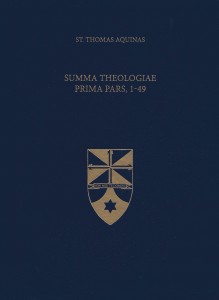The Summa Theologiae is Aquinas’s most complete, his most mature, and his clearest work. But newcomers to Aquinas and to the Summa often find themselves confused the moment they open the book, because of its unfamiliar format. It doesn’t contain chapters or essays or homilies or anything else books usually feature these days: it is divided into Questions, and Questions are divided into Articles.

The best English edition of the Summa is published by The Aquinas Institute.
A typical and clean example of this format is Summa Theologiae 1.1.1—that’s Article 1 of Question 1 of the First Part of the Summa. Aquinas begins with objections against his own position. Then he moves to the sed contra or “On the contrary,” where he gives arguments on the other side. Next, he spends a while explaining his own position. Finally, he replies to the objections one by one. The layout appears simple, but to write a good “article” is deceptively difficult. Aquinas makes it look easy because he is a master.
The article, or articulus as it is called in Latin, developed out of the scholastic disputatio. On a festival day at the medieval university, the theology faculty and students would gather to debate a pre-set proposition with one master in charge of the whole event. First the representatives of one side would stand up and present all their objections for and against the proposition under discussion. Then the master’s chief student would attempt to respond to everyone. The next day, everyone would reconvene to hear the master himself answer. That master would set out in a clear order all the objections gathered the day before against his position, as well as all of the arguments for his position, and then he would resolve the debate by explaining his own position in full. Finally, he would walk through all the objections and respond to them.
The article is a disputatio boiled down to its bones. It begins by asking whether such-and-such is the case. The objections then give all the reasons why your mind would incline to one side of the question. The sed contra—and sometimes there are several of them—then gives an initial reason why your mind would incline to the other side. At this point, the reader’s mind is tied in a knot: his mind inclines in both directions at once, and he can’t see how to put all the conflicting evidence together. The body of the article, sometimes called the respondeo, provides the key distinctions or crucial definitions to untie the knot in the reader’s mind, settling all doubt. The replies to objections then apply the insights of the respondeo to the particulars of the difficulties raised at the beginning. Sometimes this step offers the occasion to make an important point that didn’t come up in the respondeo.
To get a concrete feel for this flow, try reading Summa Theologiae 1.1.1 this way:
- Read each objection and try to answer it in your own mind. Take your time.
- Next, read the body of the article (the respondeo or “I respond that”).
- In light of the body of the article, re-read each objection and try to answer it again. Remember, take your time!
- Finally, read the replies to the objections and compare Thomas’s answers to your own. If you did not reply the way Thomas does, can you figure out why his answer is different?
I learned this method for reading the Summa from Marcus Berquist, one of my first theology teachers and one of the best readers of Aquinas I’ve known. May his soul and the souls of all the faithful departed rest in peace!







Please note: I reserve the right to delete comments that are offensive or off-topic.